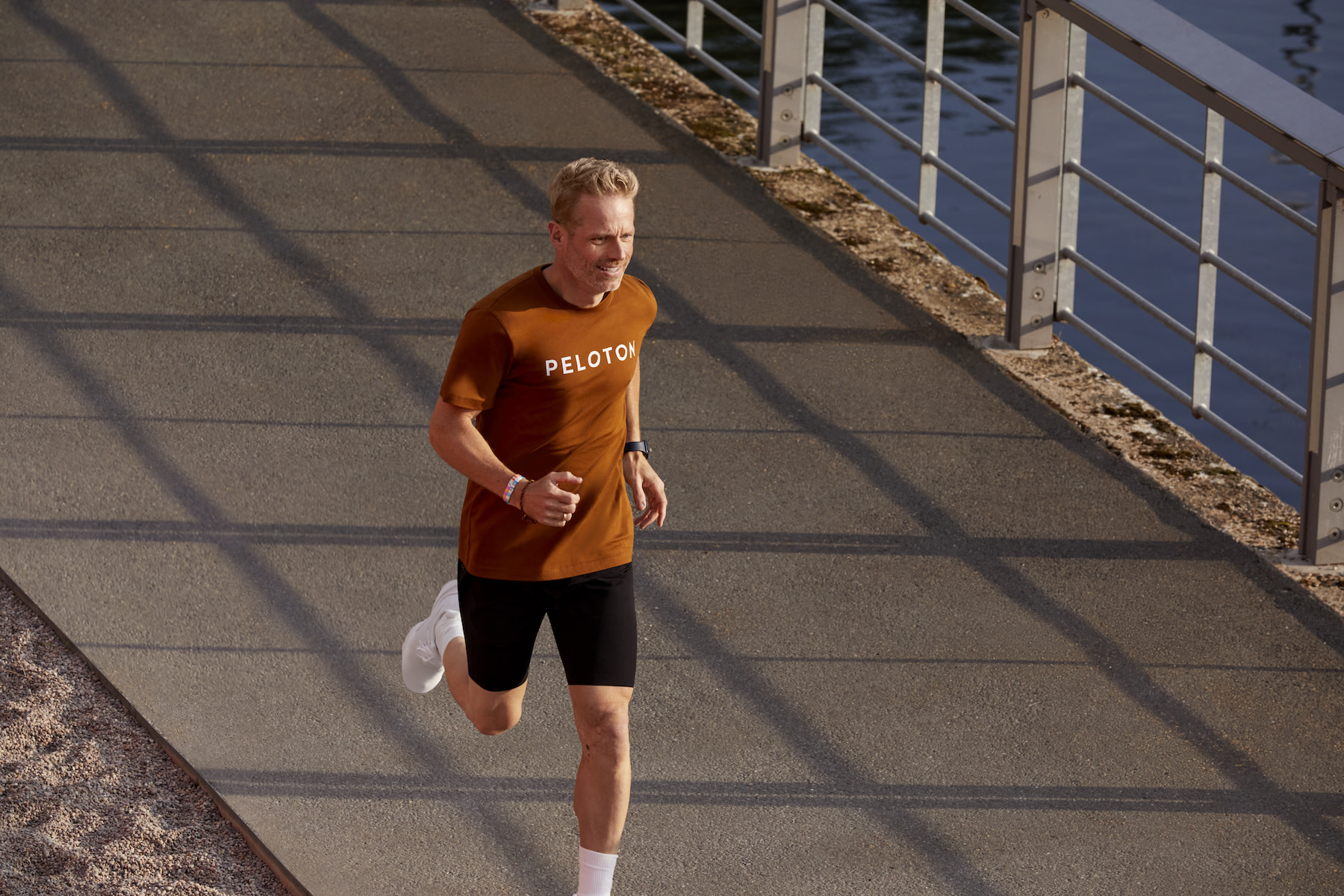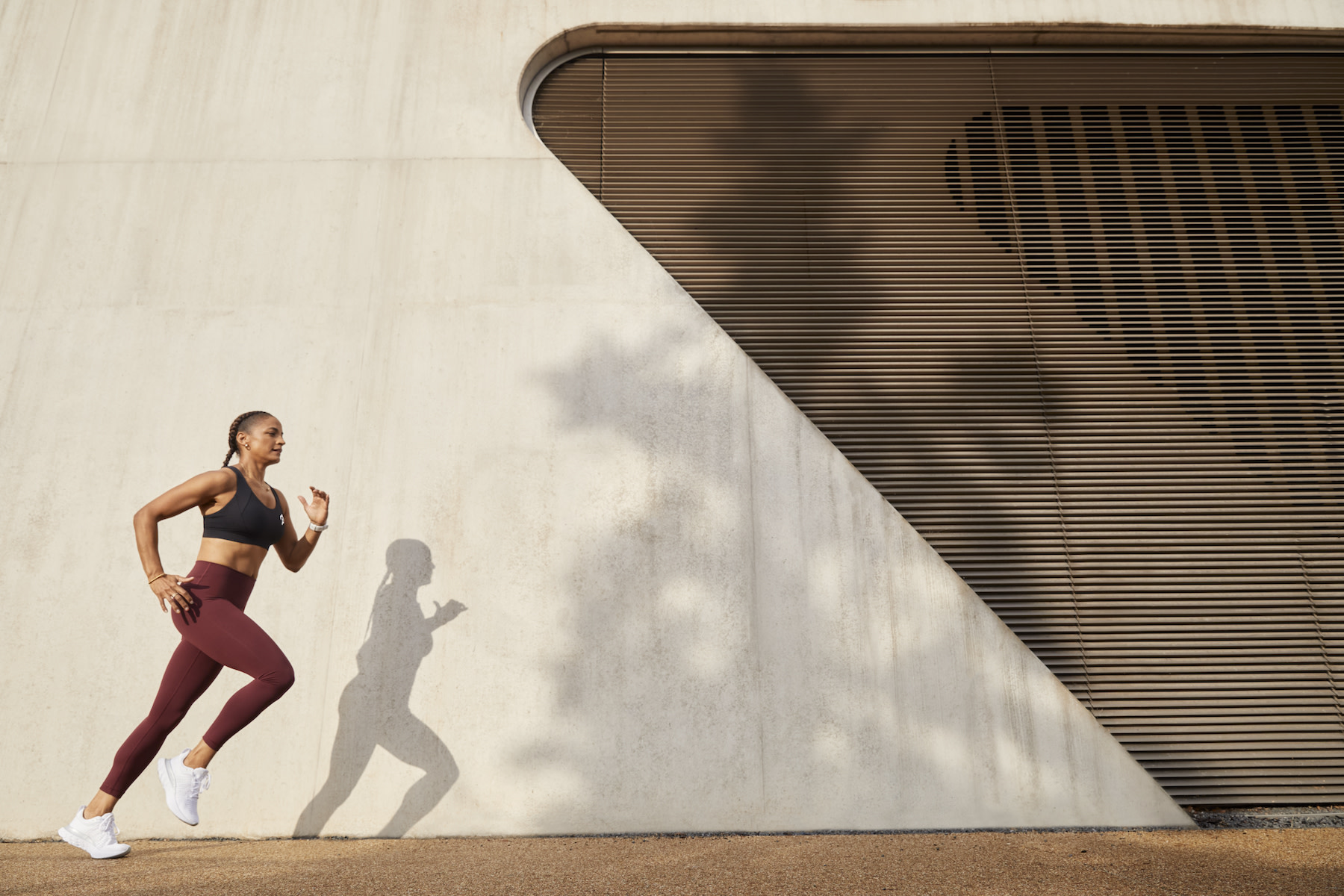
Exactly How to Nail Proper Running Form with Every Step
No matter how long you’ve been running, a form check is always a good thing.
By Peloton•
Why Is Proper Running Form Important?
What Is Proper Running Form?
How to Improve Running Form
Does Proper Running Form Change, Depending on the Type of Running?
What Techniques Can Improve Running Form?
The Takeaway
When you start out as a brand new runner, there are many things to consider: your shoes, your running route, and even perfecting your “pump up” playlist. Before you know it, there are certain things you may have neglected, like proper running form.
But if you want to be able to run faster and longer or be more comfortable during your run and less sore afterward, proper running form is key. So, whether you’re just starting out or are just looking for some running form tips, you’re in the right place.
Why Is Proper Running Form Important?
One of the most basic things you can do to instantly improve your overall running experience is to pay attention to your form when running—and make minor tweaks and adjustments as necessary.
By adjusting how you run, you’ll reap the rewards of improved performance and comfort, plus injury prevention. With proper running form, you’ll be able to use your energy more efficiently, resulting in increased stamina and faster run times. Because you’ll be less fatigued during your run, you’ll also be less prone to mistakes that could cause you to become sidelined with an injury. And yet, despite these game-changing benefits, proper running form is often overlooked by amateur athletes.

Quite simply, proper running form is essential for runners of all levels. Why, you ask? Here are the top benefits of good running form:
Performance enhancement. How you move when running can help you distribute your energy more effectively as you run. This means you’ll breathe more efficiently and require less energy per stride, building endurance and helping you run faster with less effort.
Less stress on your body. When you use proper running form, your joints, muscles, tendons, and ligaments will thank you. That’s because, with each aligned footfall, you’re safely strengthening and moving your muscles and joints rather than hurting them. Good form can help prevent many common running injuries, such as shin splints, runner’s knee, IT band syndrome, low back pain, and stress fractures.
Added comfort. It’s natural to feel a little uncomfortable as your body moves from an anaerobic to aerobic state at the beginning of a run. However, it’s not natural for any initial aches you may feel to worsen as you continue running—whether outdoors or on a treadmill. With proper running form, you’re much less likely to be sore and fatigued during and after a run. This, in turn, means running will be that much more enjoyable for you, making it more likely that you’ll stick with it.
What Is Proper Running Form?
Maintaining good form when running involves multiple components and parts of the body, including:
Posture: How you hold your body while moving
Alignment: How your feet, knees, hips, spine, shoulders, and head line up as you move
Biomechanics: How your body moves based on your unique form and structure (e.g., the length and cadence of your stride; whether there is an inversion or eversion that occurs with each foot strike)
Your running posture, alignment, and biomechanics affect so many aspects of how you move. It is something that can be seen and felt with each foot placement and arm action. The goal of breaking down and improving these components of proper running form is to optimize your performance and reduce your risk of injury.
Here are some tips to help you achieve proper running form.
Head and Neck
Your head should be in a neutral, forward-facing position. Look straight ahead as you run, with your gaze focused on the ground about 10-20 feet in front of you. This helps maintain proper spinal alignment and reduces strain on your neck and shoulders.
Upper Body Position & Running Posture
Your posture while running determines how the impact of each stride is absorbed by your body. So, you’ll want to maintain an upright and relaxed posture, with a slight forward lean from the ankles (not the waist). Engage your core muscles to further improve your balance and stability while running. Establish a rhythmic breathing pattern that synchronizes with your running cadence. This can help improve oxygen delivery to your muscles and keep you relaxed during your run, which helps prevent unnecessary muscle tension and fatigue. Keep your shoulders down and away from your ears.
Arms and Hands
Keep your arms bent at a 90-degree angle and swing them back and forth (not across the front of your body) in a controlled manner. Your hands should be relaxed (not clenched) and at waist level or thereabouts, while your elbows should stay close to your sides.
Foot Strikes
Aim for a mid-foot strike, so you land at about the center of your foot. Landing on the balls of your feet can also be effective. In both cases, you should be able to easily and powerfully push off again from that landing position. Landing on the toes is a big no-no because it is inefficient (requires more effort to push off) and can cause injury. Ditto for heel strikes, which can also put undue strain on your knees and lead to knee or hip pain. For the most efficient stride, you’ll want each foot strike to land directly under your body (not in front of your body).
Cadence
The number of steps you take per minute while running is your cadence. Your height (including leg length), weight, and general athletic ability will affect your running cadence. For most people, it’s good to focus on a shorter, more efficient stride that allows you a cadence of about 170-180 steps per minute. Are you competing? Here’s how to improve your race pace. Lower cadences mean you’re probably overstriding – so you’re spending more time in the air than on the ground, and – even worse – you’re likely landing on your heels. Higher cadences, on the other hand, can help reduce the impact on your joints and decrease injury risk.
How to Improve Running Form

So what exactly can you do to correct your running form? Peloton Tread instructor Becs Gentry addresses seven common mistakes she sees in runners and her top running form tips and corrections for making the most out of every mile.
Mistake #1: Doing too much running too soon.
This can lead to injury from overuse of muscles and joints that may have been dormant for a while.
Solution: “A new runner should start with moderate goals and gently ease into running; steady controlled progress will be the progress that never stops,” Becs says.
Mistake #2: Comparing yourself to others.
Beginners often look to very experienced and advanced runners to try to copy their exact running form and style without taking into consideration experience, body type, and speed. This can lead to injury and lack of motivation.
Solution: “Know that, as your speed increases, your body will naturally allow you to move off your toes as you run to turn over the ground quicker,” she says.
Mistake #3: Neglecting your strength training.
Strength training for runners should be an important part of your routine. Activities like cycling for runners and yoga for runners are also great cross-training methods.
Solution: “Beginners need to head to a gym and work on leg strength. Strengthening quads and hamstrings is key to achieving a powerful leg drive and overall strong running form,” according to Becs.
Mistake #4: Holding too much tension in your body.
Solution: Becs advises runners to “Avoid holding too much tension in the body while simultaneously keeping a little tension. This is something that comes from practice. A great way to start to understand this balance is to listen to your breath and focus on keeping calm when you run.”
Mistake #5: Misplaced arm position.
Letting your arms cross over your chest while you run, or not moving your arms at all are two of the most common mistakes with the arms during running.
Solution: “With proper running form, your shoulders are back and down, away from your earlobes. And your arms should have a 90-degree bend at the elbow and drive forward and backward as you move,” she says.
Mistake #6: Running with your tailbone out and your back arched.
Solution: “Your core should be engaged but not super tense,” Becs says. “And your hips should be tucked under your body – think ‘naughty dog’ tucking its tail between its legs to cue this.”
Mistake #7: Misplaced body weight.
Forcing your body weight onto your toes before you have the speed to get your legs turning over quickly.
Solution: “With every step, you should be lifting your knees and feet, driving your movement forward,” Becs recommends. “As your speed increases, you will naturally move forward to the ball of your foot and push off as you run, flicking your heels up under your torso toward your glutes.”
Does Proper Running Form Change, Depending on the Type of Running?
Depending on your speed, you may want to make specific adjustments to your form whether you’re jogging, running, or sprinting. Remember, though: No matter the type of run you’re doing, it’s still critical to maintain proper running form.
Jogging
Slower than running, a jog typically means you’re moving at a relaxed pace and low intensity. Your focus when jogging should be on maintaining a good, upright posture – with a slight forward lean from the ankles. Although your cadence will be lower than when running or sprinting, be careful when you’re jogging that you don’t overstride and land on your heels, which is not just inefficient but can be hurtful as well.
Running
Running is a moderate- to high-intensity aerobic activity. When running, focus on your breath. It’s important to breathe from the diaphragm in a rhythmic way that matches your stride. Your cadence should be between 170-190 steps per minute. This means your stride will be shorter but much more efficient use of available energy. Your arm swing may become more pronounced during a run. Just make sure you’re using the right form: forward and backward motions, with your hands relaxed and held about waist high.
Sprinting
These high-intensity bursts of speed require maximum effort for short periods of time. To achieve the fast pace of a sprint, you should be leaning forward a little more, with a foot strike nearer to the ball of the foot, for greater push-off power. Your cadence will be at an all-time high and, as you lift your leg with each step, your thigh should be parallel to the ground. Arm swings will be powerful and exaggerated, helping to drive your forward motion.
What Techniques Can Improve Running Form?
Now that you know what it is, are you ready to start using proper running form? Your body might require some practice or training before good forms feels natural to you. If that’s the case, the following may help.
Core Exercises
There are a lot of advantages to having a strong core— including that it can help you maintain proper posture and alignment while running. Try the 5-, 10-, 15-, and 20-minute Core Strength workouts on the Peloton App to help strengthen your core.
Foot Strike Practice
To practice landing on your midfoot or forefoot, there are a number of things you can do to become more conscious of and correct your foot strike. Jumping rope can help you get used to moving off the balls of your feet. Toe walks and heel walks can help strengthen muscles necessary for a midfoot or forefoot strike. And finally, moving at a faster cadence can also help you move away from heel striking, if you tend to do so.
Breathing Techniques
One of the best breathing techniques to help ensure you’re breathing from the diaphragm and that you’re doing it in a deep and steady way is breathing in through your nose and out through your mouth. An added benefit of this breathing technique is that you get to quickly get rid of carbon dioxide with each exhale. To be sure you’re breathing from your diaphragm, make sure your belly (not your chest) expands with every inhale.
The Takeaway
Achieving proper running form is essential for runners of all levels. Not only will your posture, alignment, and biomechanics affect how well and how comfortably you run—these important elements of good running can even help you avoid running injuries. If you’re new to running, here’s how to get started. The Peloton App offers an enormous variety of runs and other exercises that can help improve (and practice) your running form.
By incorporating a few practical tips—and avoiding some common mistakes—you’ll be on your way to a faster, more efficient, and more enjoyable run.
This content is for informational and educational purposes only and does not constitute individualized advice. It is not intended to replace professional medical evaluation, diagnosis or treatment. Seek the advice of your physician for questions you may have regarding your health or a medical condition. If you are having a medical emergency, call your physician or 911 immediately.
Level up your inbox.
Subscribe for a weekly dose of fitness, plus the latest promos, launches, and events.